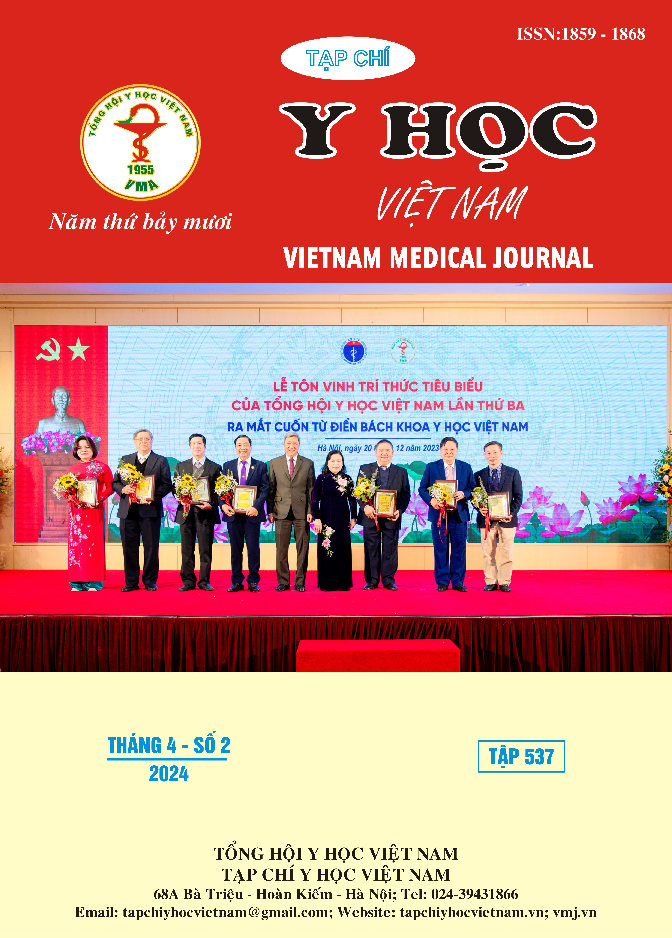RESULTS OF TOTAL LAPAROSCOPIC GASTRECTOMY WITH D2 LYMPHADENECTOMY FOLLOWED BY ROUX-EN-Y RECONSTRUCTION FOR GASTRIC ADENOCARCINOMA AT HANOI MEDICAL UNIVERSITY HOSPITAL
Main Article Content
Abstract
Objectives: To describe the clinical, paraclinical, pathology and early results of total laparaoscopic distal gastrectomy with D2 lymphadenectomy followed by intracorporelal Roux en Y recontraction for carcinoma of the stomach from June 2021 to June 2023 at Hanoi Medical University Hospital. Method: A retrospective descriptive study on 61 patients with gastric carcinoma who underwent total laparoscopic distal gastrectomy with D2 lymphadenectomy followed by intracorporelal Roux en Y recontraction. Results and discussion: The average age was 63.82 ± 10.4 years (31- 83 years). 70.05% was male. Common reasons for coming to the doctor are epigastric pain (85.25%) and weight loss (40.98%). The most common tumor is in the pyloric antrum (77.05%). The average tumor size was 3.23 ± 1.91 cm The average surgery time is 191.64 ± 45.37 minutes (100 - 360 minutes) depending on the physical condition, level of invasion and anastomosis technique of making anastomosis). No complications were recorded during surgery. The average postoperative hospital stay (SM) is 7.90 ± 3.12 days (4 - 21 days). The rate of complications after surgery was 13.11%, of which complications of acute pancreatitis were the most common, with no cases of death during or after surgery. Histopathological results were mainly adenocarcinoma (77.05%). The average number of lymph nodes dredged was 30.84 lymph nodes, the average number of metastatic lymph nodes was 3.39 ± 4.70 lymph nodes. Conclusions: total laparoscopic distal gastrectomy with D2 lymphadenectomy followed by intracorporelal Roux en Y recontraction is a safe and effective method in the treatment of gastric carcinoma.
Article Details
Keywords
Gastric carcinoma, laparoscopic surgery, Roux-en-Y.
References
2. Morgan E, Arnold M, Camargo MC, et al. The current and future incidence and mortality of gastric cancer in 185 countries, 2020–40: A population-based modelling study. eClinicalMedicine. 2022;47:101404. doi:10.1016/ j.eclinm.2022.101404
3. Sung H, Ferlay J, Siegel RL, et al. Global Cancer Statistics 2020: GLOBOCAN Estimates of Incidence and Mortality Worldwide for 36 Cancers in 185 Countries. CA Cancer J Clin. 2021;71(3):209-249. doi:10.3322/caac.21660
4. Ma G. Japanese gastric cancer treatment guidelines 2018 (5th edition). Gastric Cancer. 2020;24:1-21. doi:10.1007/s10120-020-01042-y
5. Kitano S, Shiraishi N, Uyama I, Sugihara K, Tanigawa N, Japanese Laparoscopic Surgery Study Group. A multicenter study on oncologic outcome of laparoscopic gastrectomy for early cancer in Japan. Ann Surg. 2007;245(1):68-72. doi:10.1097/01.sla.0000225364.03133.f8
6. Ramos MFKP, Pereira MA, Dias AR, Ribeiro Jr U, Zilberstein B, Nahas SC. Laparoscopic gastrectomy for early and advanced gastric cancer in a western center: a propensity score-matched analysis. Updat Surg. 2021;73(5):1867-1877. doi:10.1007/s13304-021-01097-1
7. Park JH, Jeong SH, Lee YJ, et al. Comparison of long-term oncologic outcomes of laparoscopic gastrectomy and open gastrectomy for advanced gastric cancer: A retrospective cohort study. Korean J Clin Oncol. 2018;14:21-29. doi:10. 14216/kjco.18004
8. Emam HMK, Moussa EMM, Abouelmaged M, Ibrahim MRI. Role of Multidetector CT in Staging of Gastric Carcinoma. J Cancer Ther. 2019;10(07):565-579. doi:10.4236/jct.2019.107046
9. Cianchi F, Indennitate G, Trallori G, et al. Robotic vs laparoscopic distal gastrectomy with D2 lymphadenectomy for gastric cancer: a retrospective comparative mono-institutional study. BMC Surg. 2016;16(1):65. doi:10.1186/ s12893-016-0180-z
10. Zhao LY, Zhang WH, Chen XZ, et al. Prognostic Significance of Tumor Size in 2405 Patients With Gastric Cancer: A Retrospective Cohort Study. Medicine (Baltimore). 2015;94(50): e2288. doi:10.1097/MD.0000000000002288


